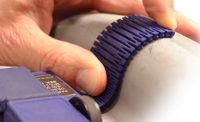- Economy gage heads: Reasonable level of performance at modest cost
- Precision gage heads: Good linearity and excellent repeatability
- Ultra-precision gage heads: Lowest error
NDT - Probes
Gaging Probes Get Results
Variations in LVDT gage head technology address different manufacturing automation applications.

Constructed entirely of stainless steel, these hermetically-sealed 19 millimeter diameter LVDT gaging probes provide long service life in various industrial uses such as industrial gaging systems, electronic dial indicators, fabricated metal products gaging, materials testing apparatus as well as large shaft TIR measurement. Hermetically sealed, spring-loaded LVDT position sensors can withstand the effects of dirt, water, steam and other corrosive elements without affecting performance. Source: Macro Sensors

Spring-loaded, AC-operated LVDT position sensors interface with single channel LVDT signal conditioners that provide either a low noise 0-10V DC or 4-20mA output for computer readout of dimensional or position measurement. Source: Macro Sensors

Figure 1 shows a cross section of a precision gage head that shows the hermetically sealed interior with space for a microelectronic signal-conditioning module. When electronics are built into a spring-loaded assembly, there is no need for external electronics, making the mechanical setup of the sensor into automated machinery less complicated and more cost effective. Source: Macro Sensors

